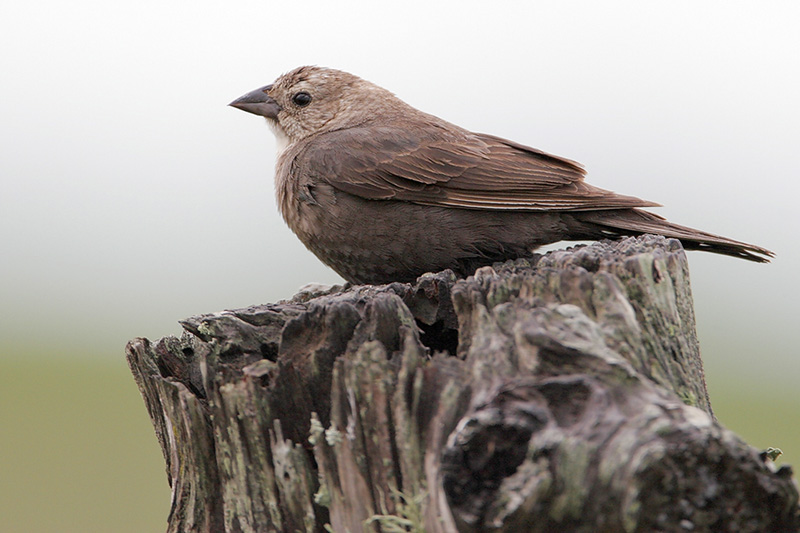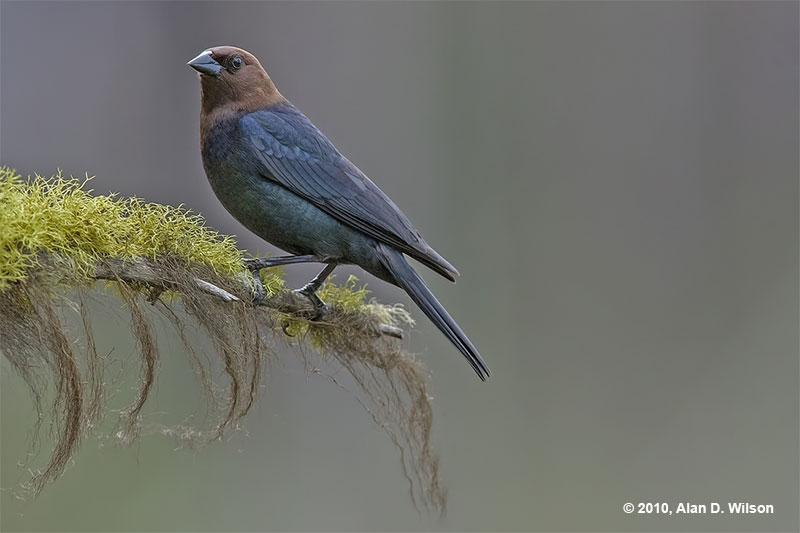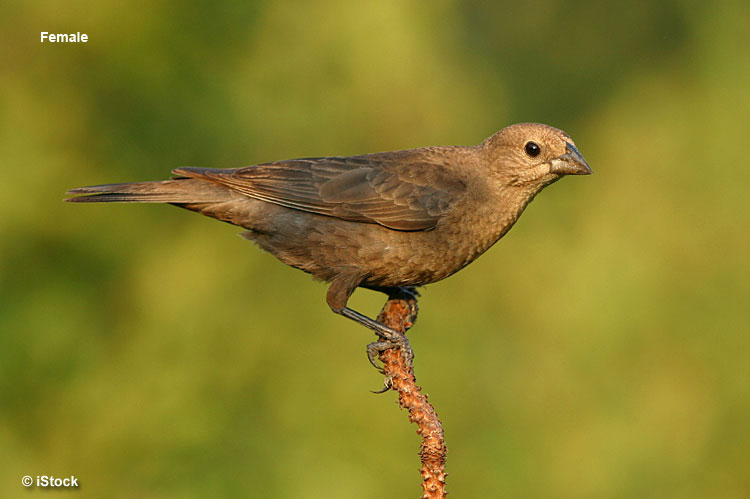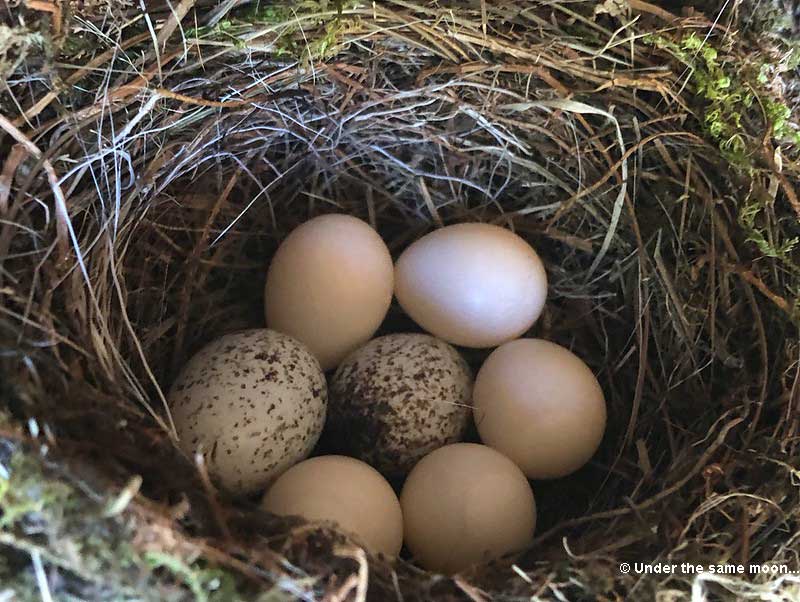
Female cowbirds are less obvious than males because of their plain brown coloring. Their duller plumage helps them blend into their surroundings, which keeps them safe.
Female cowbirds are also known to lay up to 40 eggs in one season in the nests of unsuspecting birds.
Let’s take a look at female cowbirds and their role as mothers and partners.
On this page
Female vs. Male Cowbird
Female and male cowbirds are different in a variety of ways, including in appearance. The appearance of female and male birds is so different that they’re hard to confuse.

Male cowbirds have darker plumage
Male Cowbirds have light brown heads, which is where they cot the name Brown-headed Cowbird. However, females don’t have brown heads but are brownish overall. Additionally, female cowbirds are a little bit smaller and behave differently.
Scientific Information
| Female Cowbird | Male Cowbird | |
| Bill | Female cowbirds have bills that almost look finch-like when looking at them quickly. It’s thicker based and much shorter than other blackbirds’. | Males have the same thicker based, shorter bill. |
| Size | Female cowbirds are 6.3 to 7.9 inches (16 to 20 centimeters) long, weigh 1.3 to 1.6 ounces (38 to 45 grams), and have a wingspan of 12.6 to 15.0 inches (32 to 38 centimeters). | Male cowbirds are 7.5 to 8.7 inches (19 to 22 centimeters) long, weigh 1.5 to 1.8 ounces (42 to 50 grams), and have a wingspan of 14.2 inches (36 centimeters). |
| Life Expectancy | Female cowbirds live to be about 16 years old. In captivity, they can live to be much longer. | Male cowbirds live to be about 16 years old. In captivity, they can live to be much longer.
The oldest Brown-headed Cowbird lived to be at least 16 years and 11 months old. It was a male, and he was recaptured and rereleased during additional banding operations in the state of Wisconsin. |
| Sounds | Female cowbirds make various chattering, whistling, and clicking calls. Flight whistles are another call they make which is a sequence of 2 to 5 sweeping whistles that have trills and buzzes mixed in. | Male cowbirds sing, while females do not. Their song involves a liquid-sounding sequence of low gurgling notes that are followed by sliding whistles. Additionally, like female birds, male birds make various chattering, whistling, and clicking calls. |
Plumage

Female cowbirds have brownish plumage.
Male cowbirds have rich brown heads and glossy black plumage. They can often look completely black if viewed from afar or in poor lighting.
Females are plain brown. They have thin streaking on the belly, light brown on their underparts and head, and a dark eye.
Using Other Nests
Brown-headed Cowbirds are best known for their parasitism. It sets them apart from a lot of other bird species seen in the U.S.
Since they’re brood parasites, Brown-headed Cowbirds don’t demonstrate the traditional maternal brooding, incubation, and ‘nest construction’ that we see in other bird species.
Females play no part in raising their young and have no association with their offspring.
Behavior

Female cowbird
In the winter months, female and male cowbirds are commonly seen searching for food with other bird species in parklands and farmland, but their behavior varies drastically in the spring.
Male birds are more vocal to attract a female, and females are difficult to spot because they remain hidden in vegetation. They scope out possible host nests where they can lay their eggs.
How To Tell A Younger Cowbird’s Gender?
It’s difficult to tell a younger cowbird’s gender. Juvenile birds are brown overall, have streaked underparts, and have a scaly-looking back. Immature males can sometimes be seen molting into their dark adult plumage and are patchy black and brown.
Lifecycle

Cowbird’s eggs in an Eastern Phoebe’s nest. Photograph © Under the same moon
Cowbirds don’t build their own nests. Instead, these birds lay their eggs in other birds’ nests, including dome-shaped Overbird nests, Blackbird nests, tree cavity nests, and even cup nests.
Brown-headed Cowbirds usually choose nests that have a smaller amount of eggs than their own. Over 140 host species have been described, from small birds like kinglets to large birds like meadowlarks.
- The clutch size is 1 to 7 eggs.
- Egg length can be anywhere from 0.7 to 1.0 inches (1.8 to 2.5 centimeters).
- Egg width can be anywhere from 0.6 to 0.7 inches (1.5 to 1.8 centimeters).
- The incubation period is 10 to 12 days.
- The nestling period is 8 to 13 days.
- Eggs are grayish-white to white with gray or brown spots.
Frequently Asked Questions
How can you tell a female cowbird?
Female cowbirds are plain brown overall. They have dark eyes, thin streaking on the belly, and light brown on their underparts and head.
Is it OK to remove cowbird eggs?
No, it’s not okay to remove cowbird eggs. Cowbirds are native to the United States, and they’re protected under the Migratory Bird Treaty Act. In most cases, it’s unlawful to use lethal control without a permit, and that includes the removal of their eggs.
Are cowbirds friendly?
Unfortunately, cowbirds are not as friendly as they seem. Don’t be fooled by their harmless appearance; these birds are destructive and greedy. Since they lay their eggs in other birds’ nests, their parasitism has caused other bird species to become endangered. It’s best not to befriend these birds, so they’re not encouraged to hang around your area.
Conclusions
Even though female and male cowbirds look drastically different, they have other distinctive differences as well.
Males are more vocal and have the obvious brown head, which is where they got their name from. Females are brown overall and aren’t as aggressive toward other birds.
However, it is tough to determine the gender of juvenile cowbirds, and in the case of wild cowbirds, the only ethical way to find it out is to observe their behavior.

